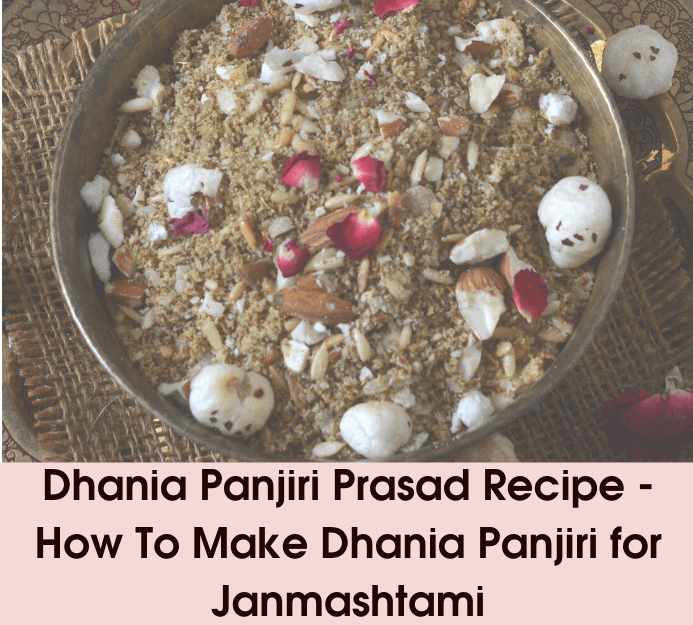How to make Dhania Panjiri Prasad for Krishna Janmashtami
Dhania panjiri or Coriander panjeeri is made to be eaten during fasting and is eaten as a prashad, especially during the occasion of Krishna Janmashtami . Coriander panjeeri is very tasty and nutritious. We can make and eat Dhaniya panjeeri anytime. All the ingredients needed for Dhania Panjiri Recipe are mentioned below. Dhania Panjiri is one of the key items offered as prashad to Lord Krishna for Janmashtami festival or Gokulashtami.
Table of Contents
Ingredients For Dhania Panjiri Prasad:
- 1 cup coriander powder,
- 1 cup powdered sugar,
- 1 Cup popped makhana (lotus seeds),
- 1/2 Cup sliced and cooked nariyal (coconut),
- 1/4 Cup desi ghee,
- 8-19 Kaju (Cashew nuts),
- 8- 10 badam (Almonds),
- 2 tbsp chironji,
- 4 Choti elaichi (Green cardamom)

How To Make Dhania Panjiri for Janmashtami
Dhania Panjiri Prasad Recipe
To make Dhania Panjiri or Coriander panjeeri for Janmashtami, cut all the dry fruits into small pieces. Cut 1 makhana into 3 or 4 parts. Cut all the dry fruits as well as the makhana. Also made some cardamom powder. To make panjeeri, first roast all the makhana. Heat a pan. Put half of the ghee in the pan. Add the sliced makhanas to the pan and cook till it gets crisp.
Keep stirring continuously. The gas should be on medium flame. Makhanas are now roasted as it has become little brown in colour and also crispy. Take the makhanas out in a bowl. Now roast the coconut on medium flame for about 1 or 1.5 minute. Once the coconut is roasted, take it out in a bowl. See that the colour has changed.
Now put the almonds and cashew nuts in the pan and cook it on medium flame for about 1 minute. Take it out in a bowl. Now roast Dhaniya powder. Now put the remaining ghee in the pan. You can use more ghee also as per your choice, but this is sufficient. Adding more ghee will give a better taste. Add coriander powder in the pan and keep stirring.
Till you get a fragrance and also till the colour does not change. While roasting, keep it on medium flame. Instead of coriander powder, you can also take coriander Seeds. Put coriander Seeds in the ghee and let it roast till it gets a little brown in colour.
After this, let it cool and then grind. It takes around 3 minutes for the coriander powder to get roasted. Now put the coriander powder in a big bowl. So that all the things are easily mixed. Add sugar powder. To make sugar powder, you have to grind sugar and filter it. Because big sugar particles should not go inside the panjeeri. As it will not taste good, so do filter it.
Add coconut, almonds, cashew nuts, chironji and cardamom powder. If you press the rosted makhanas, you will see it gets squeezed easily and can change into powder form. You can also add the powdered makhane in panjeeri.
You can make a powder by grinding the lotus seeds on a rolling board. Or if you want, you can also put them in whole. we will put them whole. They will be crunchy in the mouth and will taste great. You can add other dry fruits instead of the ones we have added according to availability and taste.
If you don’t have chironji you can replace it with melon seeds. Roast the melon seeds in a pan for some time, till it gets a little brown in colour. Mix it the same way. Our panjeeri is ready. Take out the Dhania Panjiri or coriander panjeeri in a plate. Coriander panjeeri is ready. You have made a very nice coriander panjeeri for Janmashtami festival prashad. It is so delicious that you can make it on any occasion and store it once the panjeeri gets cool, store it in an airtight container and keep eating for 2 – 3 months. Now you have learnt in detail about “How To Make Dhania Panjiri for Janmashtami”.
https://famousindianfestivals.com/janmashtami-prasad-thali/
Frequently Asked Questions:
Is dhaniya Panjiri good for health?
Dhania Panjiri is Delicious and nutritious! A joyful bite for the joyful celebration of Lord Krishna’s Birth. Dhaniya Panjiri preperation is very much popular in Janmashtami in India, but you can also make dhaniya panjiri in regular as it is very much nutritious and healthy.
Why Panjiri is made on Janmashtami?
Dhania Panjiri prasad is popular for Krishna Janmashtami celebrations because it’s associated with birthing, and is given to new moms. It has loads of dry fruits, wheat, and semolina roasted in desi ghee. Dhania Panjiri is believed to be highly nutritious.” It is a main item for Janamashtmi Krishna Puja.
What is Prasad for Janmashtami?
Lord Krishna loves everything made up with milk, including butter, curd and chaach. Therefore Lord Krishna is also called ‘Maakhan Chor. Prasad for Janmashtami is Maakhan Mishri.
Which flower does Lord Krishna likes?
Lord Krishna is the eighth incarnation of Lord Vishnu, he is fond of every luxury and class. Aromatic flowers like mogra, jasmine, tuberose, etc. are lord Krishna’s favourite flower. These flowers are used, while decorating the ‘Jhula’ for little Krishna, during Krishna Janmashtami.
What is Lord Krishna’s Favourite food?
Maakhan Mishri, is considered as Lord Krishna’s favorite. Maakhan Mishri is prepared using mixing of sugar candies and homemade clarified butter.






